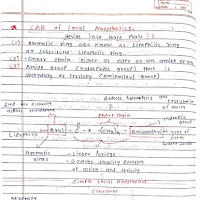SAR of Local Anaesthetics: Handwritten Notes
Download detailed handwritten notes on the Structure-Activity Relationship (SAR) of Local Anaesthetics. These notes are essential for students studying pharmaceutical chemistry and preparing for exams.
Keywords: download PDF, handwritten notes, SAR of local anaesthetics, pharmaceutical chemistry, local anaesthetics, structure-activity relationship.
SAR of Local Anaesthetics: A Comprehensive Guide
Local anaesthetics are drugs that block pain sensation in a specific area of the body without affecting consciousness. The Structure-Activity Relationship (SAR) of local anaesthetics is a critical aspect of medicinal chemistry, as it helps in understanding how the chemical structure of these drugs influences their pharmacological activity.
Key Components of SAR in Local Anaesthetics
The SAR of local anaesthetics is based on three main components:
- Lipophilic Aromatic Ring: This part of the molecule is responsible for binding to the receptor site. The aromatic ring enhances the lipid solubility of the drug, allowing it to penetrate the nerve membrane.
- Intermediate Chain: The intermediate chain connects the lipophilic aromatic ring to the hydrophilic amine group. The length and nature of this chain influence the drug's potency and duration of action.
- Hydrophilic Amine Group: This group is essential for the drug's solubility in water and its ability to interact with the sodium channels in nerve cells.
Factors Influencing SAR
Several factors influence the SAR of local anaesthetics, including:
- Lipid Solubility: Higher lipid solubility allows the drug to penetrate the nerve membrane more effectively, leading to faster onset and longer duration of action.
- pKa Value: The pKa value determines the proportion of the drug that exists in the ionized form at physiological pH. A lower pKa value results in a higher proportion of the drug in the non-ionized form, which is more effective in penetrating the nerve membrane.
- Protein Binding: Higher protein binding increases the duration of action of the drug by slowing its release from the binding site.
Examples of Local Anaesthetics
Some common examples of local anaesthetics include:
- Lidocaine: A widely used local anaesthetic with a balanced profile of potency, onset, and duration of action.
- Bupivacaine: Known for its long duration of action, making it suitable for prolonged procedures.
- Procaine: An older local anaesthetic with a shorter duration of action, often used in minor surgical procedures.
These handwritten notes provide a detailed explanation of the chemical structures, mechanisms of action, and therapeutic uses of local anaesthetics, making them an invaluable resource for students and professionals in the field of pharmaceutical chemistry.
Info!
If you are the copyright owner of this document and want to report it, please visit the copyright infringement notice page to submit a report.

